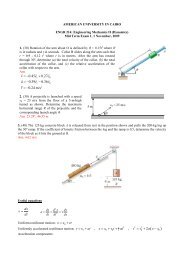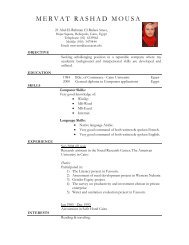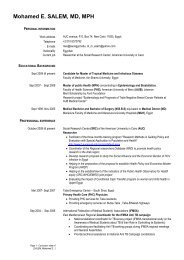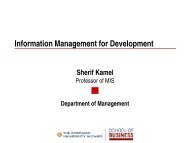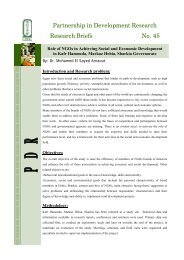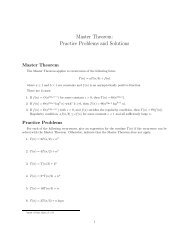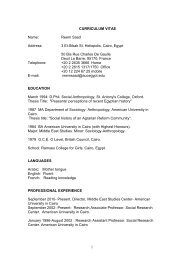Economics of Information Technology
Economics of Information Technology
Economics of Information Technology
You also want an ePaper? Increase the reach of your titles
YUMPU automatically turns print PDFs into web optimized ePapers that Google loves.
Dr Sherif Kamel<br />
Department <strong>of</strong> Management<br />
School <strong>of</strong> Business, <strong>Economics</strong> and<br />
Communication<br />
<strong>Economics</strong> <strong>of</strong> <strong>Information</strong> <strong>Technology</strong>
Outline<br />
Technological and financial trends<br />
<strong>Technology</strong> and organization<br />
Productivity paradox<br />
IT evaluation methods<br />
Value analysis<br />
<strong>Information</strong> economics<br />
Outsourcing<br />
IT contribution to economy<br />
Copyright © 2002 Turban, McLean and Wetherbe<br />
Copyright © 2005 Sherif Kamel
Technological and Financial Trends<br />
Moore’s Law<br />
o Moore suggested in 1965 that the number <strong>of</strong> transistors,<br />
and thus the power, <strong>of</strong> an integrated circuit (computer<br />
chip) would double every year while the cost remained<br />
the same<br />
o He later revised this estimate to a slightly less rapid<br />
pace: doubling every 18 months<br />
Price-to-performance ratio<br />
o Organizations will have the opportunity to buy, for the<br />
same price, twice the processing power in 1½ years,<br />
four times the power in 3 years, eight times the power in<br />
4½ years, etc…<br />
Copyright © 2002 Turban, McLean and Wetherbe<br />
Copyright © 2005 Sherif Kamel
Moore’s Law<br />
Copyright © 2002 Turban, McLean and Wetherbe<br />
Copyright © 2005 Sherif Kamel
<strong>Technology</strong> and Organizations<br />
Impact <strong>of</strong> new technologies on organizations<br />
o Most organizations will perform existing functions at<br />
decreasing costs over time and thus become more<br />
efficient<br />
o Creative organizations will find new uses for information<br />
technology based on the improving price-toperformance<br />
ratio and thus become more effective<br />
o New and enhanced products and services will provide<br />
competitive advantage to organizations that have the<br />
creativity to exploit the increasing power <strong>of</strong> information<br />
technology<br />
Copyright © 2002 Turban, McLean and Wetherbe<br />
Copyright © 2005 Sherif Kamel
Productivity Paradox<br />
Over the last 50 years, organizations have invested trillions<br />
<strong>of</strong> US dollars on IT<br />
o<br />
Total worldwide annual spending on IT in 2000 was 2 trillion US<br />
dollars, and is expected to be over 4.5 trillion dollars by 2005<br />
But is very hard to demonstrate that IT investments really<br />
have increased outputs or wages<br />
The discrepancy between measures <strong>of</strong> investment in<br />
information technology and measures <strong>of</strong> output at the<br />
national level is described as the Productivity Paradox<br />
Copyright © 2002 Turban, McLean and Wetherbe<br />
Copyright © 2005 Sherif Kamel
Explaining the Productivity Paradox<br />
Economists have developed a variety <strong>of</strong><br />
explanations for the productivity paradox that can<br />
be grouped as follows<br />
o Data and analysis problems - hide productivity gains<br />
o Gains from IT - are <strong>of</strong>fset by losses in other areas<br />
o Productivity gains - are <strong>of</strong>fset by IT costs or losses<br />
Copyright © 2002 Turban, McLean and Wetherbe<br />
Copyright © 2005 Sherif Kamel
Data and analysis problems<br />
Productivity numbers are only as good as the data used in<br />
their calculations<br />
In service industries, such as finance or health-care<br />
delivery, it is more difficult to define what the products are,<br />
how they change in quality, and how to allocate<br />
corresponding costs<br />
Productivity gains may not be apparent in all processes<br />
supported by information systems<br />
A failure to consider the time lags between IT investments<br />
and IT benefits may underestimate the productivity impacts<br />
Copyright © 2002 Turban, McLean and Wetherbe<br />
Copyright © 2005 Sherif Kamel
Offsetting the losses<br />
Sometimes IT produces gains in certain areas <strong>of</strong><br />
the economy, but these gains are <strong>of</strong>fset by losses<br />
in other areas<br />
o An organization may install a new computer system that<br />
makes it possible to increase output per employee<br />
o If the organization reduces its production staff but<br />
increases employment in unproductive overhead<br />
functions, the productivity gains from information<br />
technology will be dispersed<br />
Copyright © 2002 Turban, McLean and Wetherbe<br />
Copyright © 2005 Sherif Kamel
Offsetting <strong>of</strong> IT costs and losses<br />
IT really does not increase productivity<br />
Might be a relationship between IT spending and<br />
corporate pr<strong>of</strong>itability<br />
o Support Costs<br />
o Wasted Time<br />
o Support Development Problems<br />
o S<strong>of</strong>tware Maintenance<br />
o Incompatible systems<br />
Copyright © 2002 Turban, McLean and Wetherbe<br />
Copyright © 2005 Sherif Kamel
Evaluating IT<br />
There are multiple kinds <strong>of</strong> values, and the return on<br />
investment measured in dollar terms is only one <strong>of</strong> them<br />
Probability <strong>of</strong> obtaining a return from an IT investment<br />
depends on probability <strong>of</strong> conversion success and<br />
implementation factors into quantifiable measures<br />
The expected value <strong>of</strong> the return on IT investment in most<br />
cases will be less than that originally anticipated<br />
Copyright © 2002 Turban, McLean and Wetherbe<br />
Copyright © 2005 Sherif Kamel
IT Appraisal Methods<br />
<br />
<br />
<br />
<br />
Financial approach<br />
o<br />
These appraisal methods consider only impacts that can be monetary<br />
valued – focusing on incoming and outgoing cash flows<br />
Multi-criteria approach<br />
o<br />
These appraisal methods consider both financial impacts and non-financial<br />
impacts that cannot, or not easily be, expressed in monetary terms –<br />
employing quantitative and qualitative decision-making techniques<br />
Ratio approach<br />
o<br />
These methods use several ratios (e.g., IT expenditures vs. total turnover)<br />
to assist in IT investment evaluation<br />
Portfolio approach<br />
o<br />
These methods apply portfolios to plot several investment proposals<br />
against decision-making criteria. The portfolio methods are more<br />
informative compared to multi-criteria methods and generally use fewer<br />
evaluation criteria<br />
Copyright © 2002 Turban, McLean and Wetherbe<br />
Copyright © 2005 Sherif Kamel
Value <strong>of</strong> <strong>Information</strong>-2-Decision Making<br />
The value <strong>of</strong> information to decision making is the<br />
difference between the net benefits—benefits<br />
adjusted for costs—<strong>of</strong> decisions made using the<br />
information and decisions without the information<br />
Value <strong>of</strong> <strong>Information</strong> =<br />
Net benefits with information –<br />
Net benefits without information<br />
Copyright © 2002 Turban, McLean and Wetherbe<br />
Copyright © 2005 Sherif Kamel
Intangible Benefits<br />
<br />
<br />
<br />
Financial analyses need to consider not just tangible benefits but also<br />
intangible benefits<br />
The most straightforward solution to the problem <strong>of</strong> evaluating<br />
intangible benefits is to make rough estimates <strong>of</strong> monetary values for<br />
all intangible benefits<br />
One approach to evaluating infrastructure is to focus on objective<br />
measures <strong>of</strong> performance known as benchmarks<br />
o<br />
Metric benchmarks provide numeric measures <strong>of</strong> performance<br />
- IT expenses as percent <strong>of</strong> total revenues<br />
- Percent <strong>of</strong> ―downtime‖ (when the computer is not available)<br />
- CPU usage (as percent <strong>of</strong> total capacity)<br />
o<br />
Best-practice benchmarks emphasize how information system<br />
activities are actually performed rather than numeric measures <strong>of</strong><br />
performance<br />
Copyright © 2002 Turban, McLean and Wetherbe<br />
Copyright © 2005 Sherif Kamel
Total Cost <strong>of</strong> Ownership (TCO)<br />
TCO is a formula for calculating the cost <strong>of</strong> owning and<br />
operating a PC<br />
Cost includes hardware, technical support, maintenance,<br />
s<strong>of</strong>tware upgrades, and help-desk and peer support<br />
By identifying such costs, organizations get more accurate<br />
cost-benefit analyses and also reduce the TCO<br />
It is possible to reduce TCO <strong>of</strong> workstations in networked<br />
environments by as much as 26% by adopting best<br />
practices in workstation management<br />
Copyright © 2002 Turban, McLean and Wetherbe<br />
Copyright © 2005 Sherif Kamel
Value Analysis<br />
Allows users to evaluate intangible benefits on a<br />
low-cost, trial basis before deciding whether to<br />
commit to a larger investment<br />
o Keen (1981) developed the value analysis method to<br />
assist organizations considering investments in decision<br />
support systems (DSSs)<br />
Copyright © 2002 Turban, McLean and Wetherbe<br />
Copyright © 2005 Sherif Kamel
<strong>Information</strong> <strong>Economics</strong><br />
Focuses on the application <strong>of</strong> IT in areas where its<br />
intangible benefits contribute to performance on key<br />
aspects <strong>of</strong> organizational strategies and activities<br />
It incorporates the technique <strong>of</strong> scoring methodologies,<br />
which are used in many evaluation situations<br />
Scoring methodology is used by analysts to first identify all<br />
the key performance issues and assign a weight to each<br />
one<br />
Organizational objectives are used to determine which<br />
factors to include, and what weights to assign in the<br />
scoring methodology (tangible and intangible benefits)<br />
Copyright © 2002 Turban, McLean and Wetherbe<br />
Copyright © 2005 Sherif Kamel
Outsourcing<br />
<br />
<br />
<br />
Many organizations may not be able to manage IT as well as firms<br />
that specialize in managing IT<br />
For such organizations, the most effective strategy is outsourcing<br />
o<br />
o<br />
Outsourcing is the process <strong>of</strong> obtaining services from vendors,<br />
rather than from within the organization<br />
The decision to outsource usually considers two factors:<br />
Since the late 1980s, many organizations are outsourcing the<br />
majority <strong>of</strong> their IT functions<br />
o<br />
In the mid-1990s, IBM, EDS, and Computer Sciences Corp<br />
were winning approximately two-thirds <strong>of</strong> the largest outsourcing<br />
contracts<br />
Copyright © 2002 Turban, McLean and Wetherbe<br />
Copyright © 2005 Sherif Kamel
Offshore Outsourcing<br />
Offshore outsourcing <strong>of</strong> s<strong>of</strong>tware development<br />
has become a common practice in recent years<br />
o<br />
About 33% <strong>of</strong> Fortune 500 companies have started to outsource<br />
s<strong>of</strong>tware development to s<strong>of</strong>tware companies in India<br />
Copyright © 2002 Turban, McLean and Wetherbe<br />
Copyright © 2005 Sherif Kamel
Outsourcing Advantages<br />
<br />
<br />
<br />
<br />
<br />
<br />
Financial<br />
o<br />
Avoid heavy capital investment, thus releasing funds for other uses<br />
Technical<br />
o<br />
o<br />
Be freer to choose s<strong>of</strong>tware due to a wider range <strong>of</strong> hardware<br />
Achieve technological improvements more easily<br />
Management<br />
o<br />
o<br />
Concentrate on developing and running core business activity<br />
Delegate IT development (design, production, and acquisition) and<br />
operational responsibility to supplier<br />
Human Resources<br />
o<br />
o<br />
Draw on specialist skills, available from a pool <strong>of</strong> expertise<br />
Enrich career development and opportunities for staff<br />
Quality<br />
o<br />
o<br />
Clearly define service levels<br />
Improve performance accountability<br />
Flexibility<br />
o<br />
o<br />
Respond quickly to business demands<br />
Handle IT peaks and valleys more effectively<br />
Copyright © 2002 Turban, McLean and Wetherbe<br />
Copyright © 2005 Sherif Kamel
Outsourcing Risks<br />
Shirking occurs when a vendor deliberately underperforms<br />
while claiming full payment<br />
o<br />
Billing for more hours than worked, providing excellent staff first<br />
and later replacing them with less qualified ones<br />
Poaching occurs when a vendor develops a strategy and<br />
strategic application for a client and then uses them for<br />
other clients<br />
o<br />
Vendor redevelops similar systems for other clients at much lower<br />
cost, or vendor goes into client’s business<br />
Opportunistic re-pricing occurs when a client enters into a<br />
long-term contract with a vendor and vendor changes<br />
financial terms at some point or overcharges for<br />
unanticipated enhancements and contract extensions<br />
Copyright © 2002 Turban, McLean and Wetherbe<br />
Copyright © 2005 Sherif Kamel
<strong>Information</strong> Age<br />
Faster, Better, Cheaper!<br />
MOORE (1998) "If the automobile industry advanced as<br />
rapidly as the semiconductor industry, a Rolls Royce would<br />
get half a million miles per gallon, and it would be cheaper<br />
to throw it away than to park it―<br />
Invention <strong>of</strong> the transistor<br />
o Development <strong>of</strong> the semiconductor technology<br />
Integrated circuit<br />
o Memory chips
Log Scale (1996=1)<br />
10,000<br />
Relative Prices <strong>of</strong> Computers, Communications and S<strong>of</strong>tware, 1948-2003<br />
All price indexes are divided by the output price index<br />
1,000<br />
100<br />
10<br />
1<br />
0<br />
1948 1953 1958 1963 1968 1973 1978 1983 1988 1993 1998 2003<br />
Computers Communications S<strong>of</strong>tware<br />
Copyright © 2005 Jorgenson
Annual Contribution (%)<br />
Contributions <strong>of</strong> IT2TFP Growth<br />
1.20<br />
1.00<br />
0.80<br />
0.60<br />
0.40<br />
0.20<br />
0.00<br />
1948-73 1973-89 1989-95 1995-03<br />
Non-IT Production<br />
IT Production<br />
Copyright © 2005 Jorgenson
Capital Input Contribution <strong>of</strong> IT<br />
2.5<br />
2.0<br />
1.5<br />
1.0<br />
0.5<br />
0.0<br />
1948-73 1973-90 1990-95 1995-99<br />
Copyright © 2005 Jorgenson<br />
Non-IT Capital Services<br />
IT Capital Services



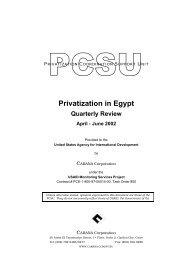
![Download entire catalog in pdf format [1.5MB] - The American ...](https://img.yumpu.com/51079239/1/190x260/download-entire-catalog-in-pdf-format-15mb-the-american-.jpg?quality=85)

